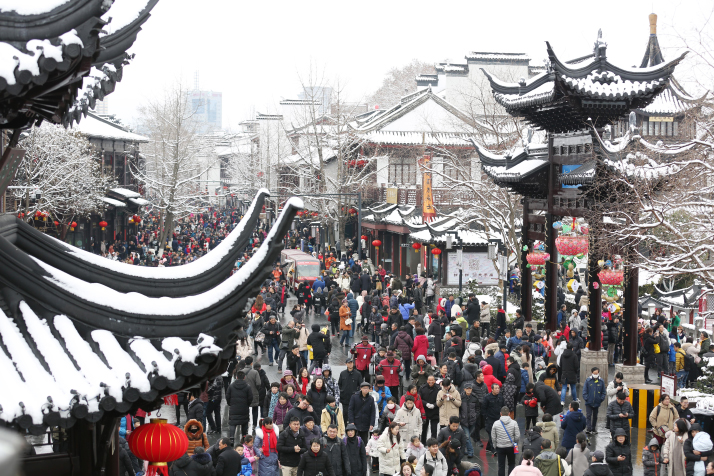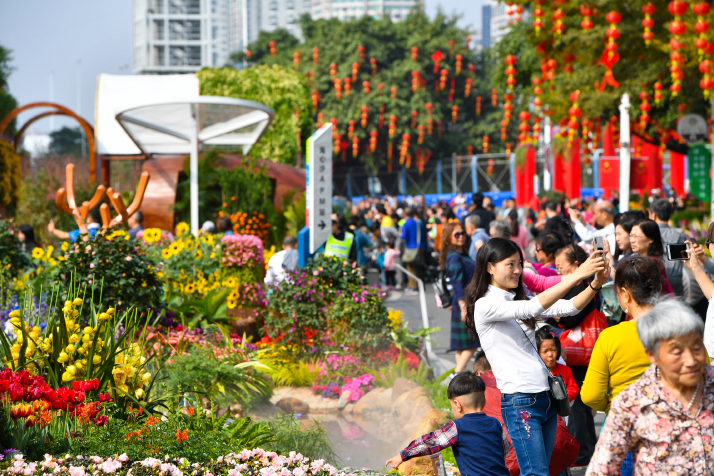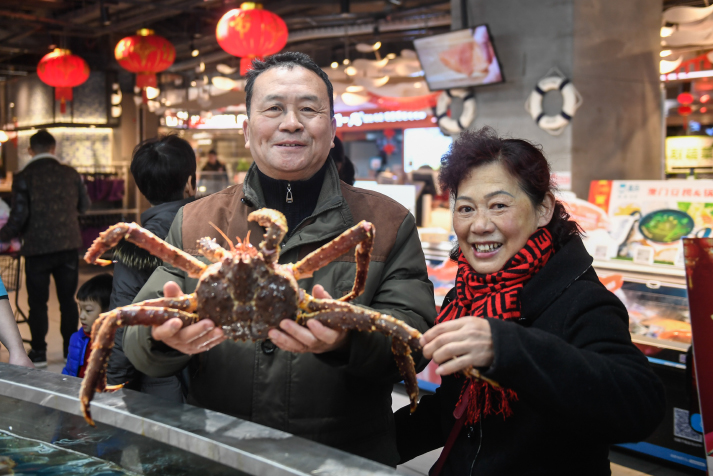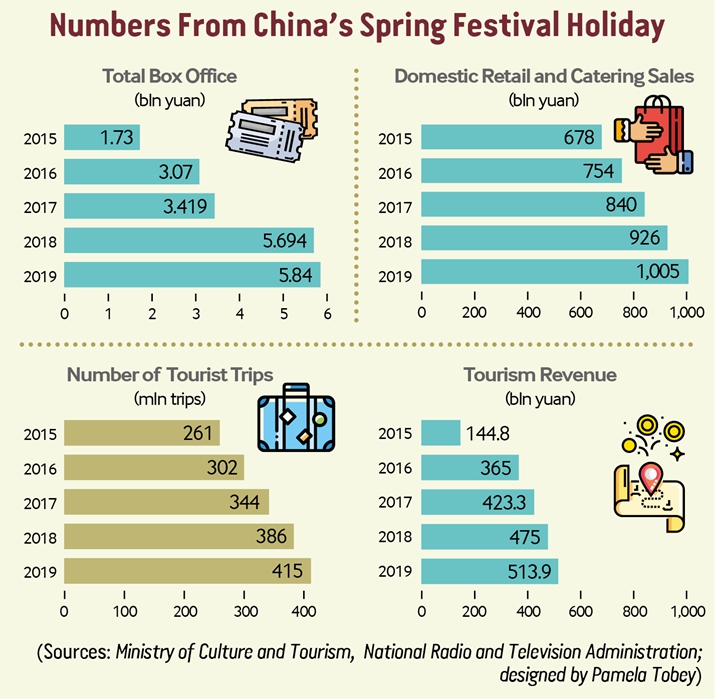| Business |
| Spring Festival, Spending Festival | |
| People expand their entertainment prospects during the Chinese New Year holiday | |
|
|
 The Confucius Temple area in Nanjing, east China's Jiangsu Province is a major tourist attraction during the Spring Festival holiday (XINHUA)
A pig-shaped bronze vessel, with a history of over 3,000 years, went on display for the first time at the Shanghai Museum during the Spring Festival Golden Week, which started on February 4. People took pictures of this must-see item and wished for good luck in the Chinese Lunar Year of the Pig. The Shanghai Museum remained open throughout the holiday. Among 131 museums in the city, 84 were open and 65 for free. Cultural activities were also held in addition to regular exhibits. Li Lei, Curator of the Shanghai Art Museum, which was the China Pavilion during the 2010 Shanghai World Expo, said going to museums over the Spring Festival has become trendy. "The number of visitors has been increasing in recent years," he added. Statistics from the Ministry of Culture and Tourism show that the number of visitors to museums, galleries and libraries surged 40.5 percent, 44.2 percent and 40.6 percent, respectively, this year. The Palace Museum in central Beijing, with its special exhibition providing an immersive royal experience for visitors, became a popular attraction. All admission tickets for the Spring Festival period were booked in advance with 500,000 people visiting over the seven-day period. Public enthusiasm for museums ran equally high nationwide. The Henan Museum in central China, for example, received over 8,000 visitors on February 6, the second day of the Chinese Lunar New Year, twice the figure on a regular weekend.  The flower market in Guangzhou, south China's Guangdong Province, attracts many people on February 4 (XINHUA)
Festival travelers Tourists contributed to the surge of visitors. Statistics from the Ministry of Culture and Tourism show that Chinese people made 420 million domestic trips during the Spring Festival holiday and 40 percent of travelers visited museums on their trips. According to Zhang Xiaoding, General Manager of the Shanghai Grand Theater, over 20 percent of the audience during the holiday were tourists. Normally, most of the audience comprises Shanghai residents. In Beijing, a total of 383 performances during the golden week lured 192,000 audience members, an increase of 18 percent from last year. "Beijing is famous for its culture," said Zhong Zhen, a tourist from central China's Hubei Province who watched a tap dance performance at the National Center for the Performing Arts. "The Spring Festival is a good opportunity for us to sit down together and watch a show." Harbin, capital of Heilongjiang Province in the northeast, Sanya in tropical Hainan Province in the south, and Xiamen, a coastal city in Fujian Province in the southeast are the top three domestic destinations for long-distance travelers during the holiday, according to the ministry. During the first six days of the holiday, eight major tourist attractions in Sanya received more than 800,000 visitors. Hotels witnessed an increase in guests. "Harbin is famous for its ice and snow activities," Wang Lijun, owner of the Qushe Guesthouse, a family inn in Harbin, said. "As traditions of celebrating the Spring Festival vary all over the country, guests here can experience how we celebrate it. This is unique especially for tourists from south China." During the festival, Qushe accommodated eight families. They made dumplings and watched the Spring Festival Gala on the China Central Television network together on the Lunar New Year's Eve. Statistics show that the number of overseas trips taken by Chinese jumped 28 percent year on year. Resort islands in neighboring countries saw an increase in Chinese tourists. Ctrip, a Shanghai-based online travel agency, said Thailand, Indonesia, Singapore, Viet Nam and Malaysia were among the most popular outbound destinations. Teng Xiaodan, a 31-year-old Beijing resident, spent the holiday with her parents and fiancé in Malaysia. "We had a lot of fun and my parents were excited to encounter so many sea creatures that they had never seen before," Teng told Beijing Review. "We plan to spend the next holidays exploring more diving destinations. For me, this is a better way to enjoy a family reunion than just cooking and eating at home."  Customers buy seafood for their Lunar New Year's Eve dinner at a supermarket in Hangzhou, east China's Zhejiang Province, on February 4 (XINHUA)
 A spending spree Movies released during the Spring Festival started to occupy a large share of the movie market several years ago. The weeklong Spring Festival holiday has become a battleground for movie makers akin to public holiday releases in the United States. This year, eight movies were released on February 5, the Chinese New Year's Day. Audiences were also in a battle. A battle for tickets. Most cinemas were fully booked in advance for February 5 with prices more than doubling in some instances. Sci-fi blockbuster The Wandering Earth, a dark horse in the movie market this year, made a shock mark by grossing more than 2 billion yuan ($294 million) in box-office receipts by February 10, becoming this year's box-office smash. The total box-office revenue for the holiday period exceeded 5 billion yuan ($735 million), setting a new record. "The Spring Festival is more like a consumption feast," Han Chengzhong, a lawyer working in Beijing, told Beijing Review. "Even if you don't go to cinemas, you don't travel, you can't escape from it." During the golden week, the retail and catering sectors posted sales of more than 1 trillion yuan ($149 billion), a year-on-year increase of 8.5 percent. Han ordered a package of organic vegetables as well as some semi-prepared food online for her parents living in north China's Hebei Province. "Many e-commerce platforms offered discounts during the festival. It is like another shopping festival." E-commerce giant JD.com said its sales between February 3 and 8 rose 42.7 percent year on year, with smartphones, computers and household appliances being the top three items. Sales of cooking utensils posted the most substantial growth, up 399 percent from last year. Due to the expanding e-commerce network, online shopping in lower-tier cities saw a boom with sales growth in small cities and towns exceeding 60 percent during the holiday. Lunar New Year's Eve dinners and family reunion feasts dominated festival dining consumption. But a growing number of Chinese chose not to cook at home. In Tianjin, 36 major restaurants received 12,000 orders for Lunar New Year's Eve dinners, an increase of 5.3 percent from 2018. The revenue in Beijing's major restaurants saw an increase of more than 10 percent compared to last year. Meanwhile, many chefs offered their services online, offering to cook in person at a client's home. "Our chefs for home dinners are in great demand," Wang Lianghong, manager of a restaurant in Zhoushan City, east China's Zhejiang Province, said. "We offered the service this year with 10 chefs. They were all reserved in advance." Copyedited by Craig Crowther Comments to yuanyuan@bjreview.com |
|
||||||||||||||||||||||||||||
|
